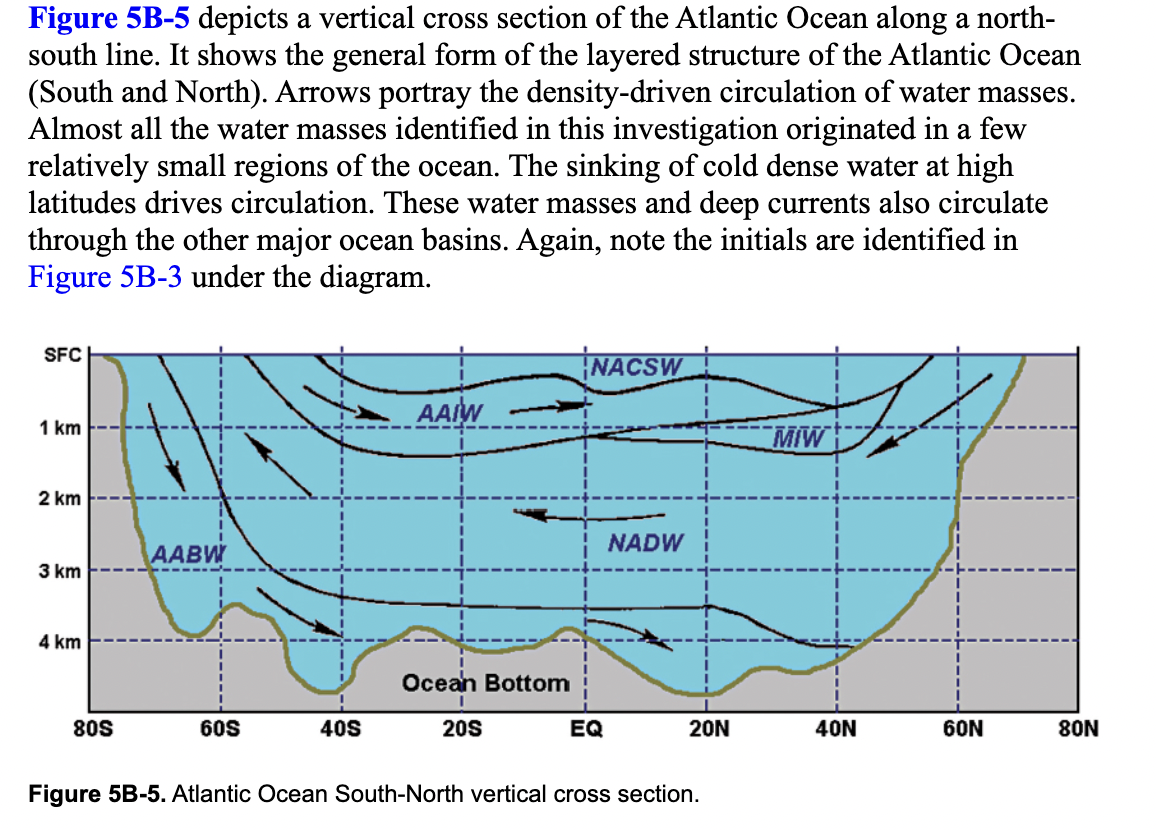16. Why does bottom water form in the Antarctic Ocean but not the Mediterranean Sea? a. Antarctic water is very fresh. b. Antarctic water is very cold. c. Mediterranean water is very fresh. d. Mediterranean water is very cold.
16. Why does bottom water form in the Antarctic Ocean but not the Mediterranean Sea? a. Antarctic water is very fresh. b. Antarctic water is very cold. c. Mediterranean water is very fresh. d. Mediterranean water is very cold.
Applications and Investigations in Earth Science (9th Edition)
9th Edition
ISBN:9780134746241
Author:Edward J. Tarbuck, Frederick K. Lutgens, Dennis G. Tasa
Publisher:Edward J. Tarbuck, Frederick K. Lutgens, Dennis G. Tasa
Chapter1: The Study Of Minerals
Section: Chapter Questions
Problem 1LR
Related questions
Question

Transcribed Image Text:Figure 5B-5 depicts a vertical cross section of the Atlantic Ocean along a north-
south line. It shows the general form of the layered structure of the Atlantic Ocean
(South and North). Arrows portray the density-driven circulation of water masses.
Almost all the water masses identified in this investigation originated in a few
relatively small regions of the ocean. The sinking of cold dense water at high
latitudes drives circulation. These water masses and deep currents also circulate
through the other major ocean basins. Again, note the initials are identified in
Figure 5B-3 under the diagram.
SFC
NACSW
AAIW
1 km
MIW
2 km
NADW
ААВW
3 km
4 km
Ocean Bottom
80S
60S
40S
20s
EQ
20N
40N
60N
80N
Figure 5B-5. Atlantic Ocean South-North vertical cross section.

Transcribed Image Text:16. Why does bottom water form in the Antarctic Ocean but not the Mediterranean
Sea?
a. Antarctic water is very fresh.
b. Antarctic water is very cold.
c. Mediterranean water is very fresh.
d. Mediterranean water is very cold.
Expert Solution
This question has been solved!
Explore an expertly crafted, step-by-step solution for a thorough understanding of key concepts.
This is a popular solution!
Trending now
This is a popular solution!
Step by step
Solved in 4 steps

Recommended textbooks for you

Applications and Investigations in Earth Science …
Earth Science
ISBN:
9780134746241
Author:
Edward J. Tarbuck, Frederick K. Lutgens, Dennis G. Tasa
Publisher:
PEARSON

Exercises for Weather & Climate (9th Edition)
Earth Science
ISBN:
9780134041360
Author:
Greg Carbone
Publisher:
PEARSON

Environmental Science
Earth Science
ISBN:
9781260153125
Author:
William P Cunningham Prof., Mary Ann Cunningham Professor
Publisher:
McGraw-Hill Education

Applications and Investigations in Earth Science …
Earth Science
ISBN:
9780134746241
Author:
Edward J. Tarbuck, Frederick K. Lutgens, Dennis G. Tasa
Publisher:
PEARSON

Exercises for Weather & Climate (9th Edition)
Earth Science
ISBN:
9780134041360
Author:
Greg Carbone
Publisher:
PEARSON

Environmental Science
Earth Science
ISBN:
9781260153125
Author:
William P Cunningham Prof., Mary Ann Cunningham Professor
Publisher:
McGraw-Hill Education

Earth Science (15th Edition)
Earth Science
ISBN:
9780134543536
Author:
Edward J. Tarbuck, Frederick K. Lutgens, Dennis G. Tasa
Publisher:
PEARSON

Environmental Science (MindTap Course List)
Earth Science
ISBN:
9781337569613
Author:
G. Tyler Miller, Scott Spoolman
Publisher:
Cengage Learning

Physical Geology
Earth Science
ISBN:
9781259916823
Author:
Plummer, Charles C., CARLSON, Diane H., Hammersley, Lisa
Publisher:
Mcgraw-hill Education,